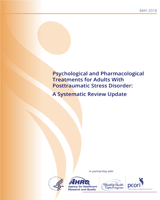From: Evidence Summary

Psychological and Pharmacological Treatments for Adults With Posttraumatic Stress Disorder: A Systematic Review Update [Internet].
Comparative Effectiveness Review, No. 207.
Forman-Hoffman V, Middleton JC, Feltner C, et al.
Rockville (MD): Agency for Healthcare Research and Quality (US); 2018 May.
NCBI Bookshelf. A service of the National Library of Medicine, National Institutes of Health.